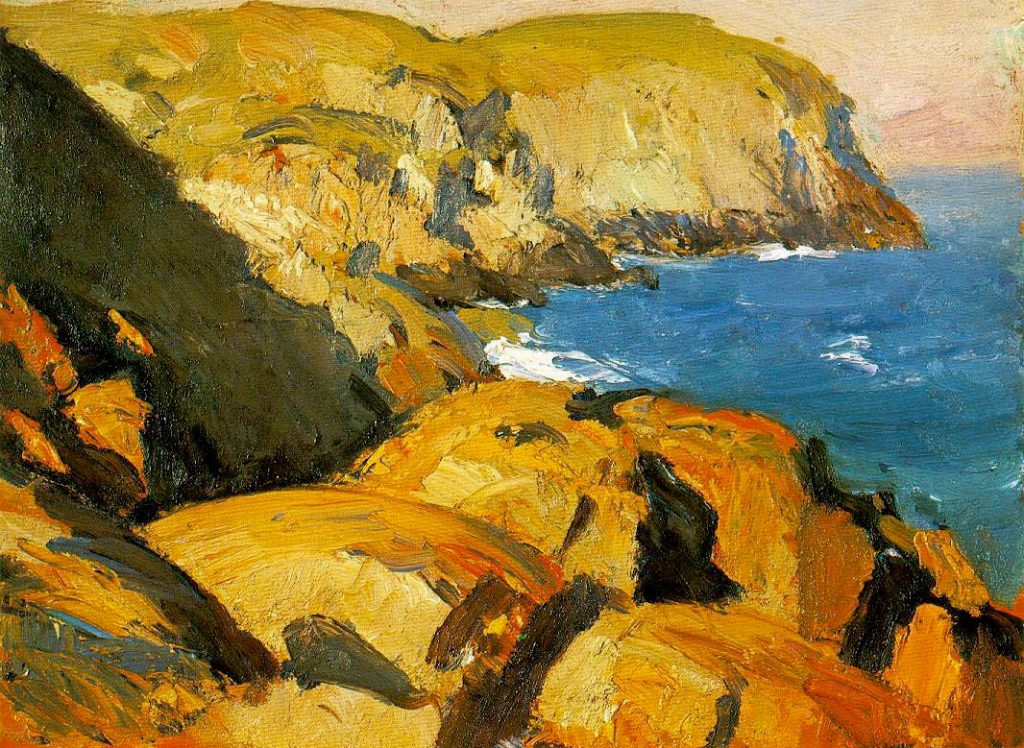Edward Hopper – Blackhead, Monhegan – 1916-1919


On this day in 1914, a Serbian nationalist assassinated Archduke Franz Ferdinand of Austria-Hungary, setting in motion a series of events that led to a century of warfare and helped create the world we live in today. The Middle East, Soviet Russia, the Cold War, the hegemony of the United States- all these came from this one act of violence. The world has never been the same.
On this day in 1864, Union General William T. Sherman (known locally as “that bastard from Cleveland”) launches a major attack on Confederate General Joseph Johnston’s army at the Battle of Kennesaw Mountain in Georgia.
In the days leading up to the assault at Kennesaw Mountain, Sherman tried to flank Johnston. Since one of Johnston’s generals, John Bell Hood, attacked at Kolb’s Farm, Georgia, and lost 1,500 precious Confederate soldiers, Sherman believed that Johnston’s line was stretched thin and that an assault would break the Rebels. So he changed his tactics and planned a move against the center of the Confederate lines around Kennesaw Mountain. He feigned attacks on both of Johnston’s flanks, then hurled 8,000 men at the Confederate center. It was a disaster. Entrenched Southerners bombarded the Yankees, who were attacking uphill. Three thousand Union troops fell, compared with just 500 Confederates.
All this area was my old stomping grounds- I grew up in Smyrna, Georgia, which is just slightly southwest of Kennesaw Mountain. The area around Kennesaw, Marietta, and Smyrna is dotted with the battlefields of the Battle of Atlanta. If you have any curiosity at all you cannot help but get steeped in Civil War lore.
Before the growth of Atlanta exploded in the Seventies, the whole area was nothing but farms and sleepy little southern towns. Everyone had ancestors and family who had been affected by the Sherman’s leadup to the March to the Sea. On every back road and many small fields were the familiar signs telling of this and that short battle that happened while the armies marched back and forth north of Atlanta.
Alas, except for the signs, all that is gone now, swallowed by the megalopolis that Atlanta has become. The towns and the byways that I grew up in no longer exist- only the names remain, and a suburban sameness.

It was not hard to leave there.
That said, I’ll always remember how it was ‘way back when; the walks at Cheatham Hill, the old monument to the soldiers of Illinois that stood there, the guns that still stood on top of the Mountain where you could see the impossible task of the Union soldiers who charged up the slopes, and all the quiet places now buried under concrete and asphalt.

Wikipedia:
Edward Hopper (July 22, 1882 – May 15, 1967) was a prominent American realist painter and printmaker. While he was most popularly known for hisoil paintings, he was equally proficient as a watercolorist and printmaker in etching. Both in his urban and rural scenes, his spare and finely calculated renderings reflected his personal vision of modern American life.[1]
…
In his early self-portraits, Hopper tended to represent himself as skinny, ungraceful, and homely. Though a tall and quiet teenager, his prankish sense of humor found outlet in his art, sometimes in depictions of immigrants or of women dominating men in comic situations. Later in life, he mostly depicted women as the figures in his paintings.[12] In high school, he dreamed of being a naval architect, but after graduation he declared his intention to follow an art career. Hopper’s parents insisted that he study commercial art to have a reliable means of income.[13] In developing his self-image and individualistic philosophy of life, Hopper was influenced by the writings of Ralph Waldo Emerson. He later said, “I admire him greatly…I read him over and over again.”[14]
Through him, a glimpse of a doomed America from the pre-Great War times to the cynical 20’s…